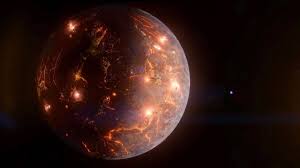A planet that orbits a faint star in our galaxy and is approximately the same size as Earth is providing strong proof of volcanic activity outside of our solar system.
According to scientific speculation, this rocky globe is probably covered with volcanoes, similar to Jupiter’s moon Io, which is well known for its intense volcanic activity. Researchers think that the gravitational interaction with a larger adjacent planet causes the newly discovered planet to experience heating and surface volcanic activity, similar to Io, even if direct detection of the planet’s volcanism is not yet possible.
This planet is slightly larger than Earth and circles a red dwarf star. It is located in the Milky Way’s Crater constellation, around 86 light-years from our solar system. The planet completes its elliptical circle around the star, which is considerably smaller and cooler than our sun, in just 2.8 days. The planet is located in the habitable zone, often known as the Goldilocks zone, where conditions may be favourable for liquid water and possibly life. Its surface temperature looks to be a little warmer than Earth.
The duration of the outgassing processes on planets and volcanism are two topics that still require a lot of research. Kane emphasises the continual investigation and discovery of our planetary neighbours by pointing out that Venus, Earth’s twin planet, has only lately been discovered to be volcanically active.
Topics #discovery #emphasises #investigration #Planet #planetary #process











